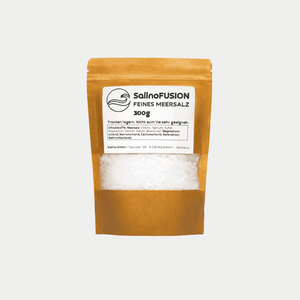When air becomes a burden
It often starts inconspicuously. A brief tickle in the nose, a dry cough, a burning sensation in the eyes in the morning. You might think of the onset of a cold or spring pollen. But what if the real cause lies much closer – in your bedroom, your sofa, your favorite book?
House dust isn't just a dirt problem. It's a biological microcosm of skin flakes, mites, pollen, mold spores, and textile fibers – and it's always there, even in the cleanest home. We breathe it in every day, hour after hour, night after night. And for millions of people, that means irritation, allergies, and shortness of breath.
The WHO estimates that indoor air pollution causes millions of illnesses worldwide each year – house dust is a silent, underestimated factor. For people with asthma, atopic dermatitis, or chronic bronchitis, it can become a constant trigger. But even healthy people react – with sleep disturbances, exhaustion, and concentration problems.
In this article, we'll take you on a deeper journey through what we call "home" – and show you how house dust affects our health in five invisible ways. And how you can protect yourself without falling into sterile perfection. Because life isn't germ-free – but it can become clearer, freer, and healthier.
1. The nighttime attack: How house dust sabotages our sleep
 Sleep should be healing. A time of regeneration, where body and mind recover. But what if it's precisely during these hours that our immune system is firing on all cylinders—not to heal us, but to defend itself?
Sleep should be healing. A time of regeneration, where body and mind recover. But what if it's precisely during these hours that our immune system is firing on all cylinders—not to heal us, but to defend itself?
Skin flakes, fibers, and moisture accumulate daily in bed. This is the ideal habitat for dust mites. Warm, humid, and dark – perfect conditions for the small arachnids that nest invisibly in the fabric. They themselves are harmless, but their excretions are considered one of the most common triggers of allergies in Europe.
People with a so-called house dust allergy —more accurately, dust mite excrement allergy—often experience a silent ordeal at night. Their nose swells, a cough wakes them from sleep, their eyes burn, and their throat feels dry. According to the German Allergy and Asthma Association, approximately ten percent of the population suffers from this form of allergy, and the trend is rising.
Yet even without an official diagnosis, many sufferers report similar symptoms. The difference is that their complaints are rarely associated with their sleeping environment. And so the true cause often remains hidden for a long time.
Sleep disorders as early warning signs
If you wake up with a headache in the morning, feel restless, or regularly cough at night, this could be a sign that your body is struggling with something—even without a fever, runny nose, or any obvious illness. The constant irritation of the respiratory tract not only disrupts deep sleep but also the hormonal regeneration that should occur at night. The result: exhaustion despite getting enough sleep.
These chronic stressors often lead to subsequent problems—such as increased stress levels, a weakened immune system, or even depression. Poor sleep isn't just annoying—it changes what we feel, think, and do.
First steps towards a dust-free night
A radically dust-free bedroom is an illusion. But there are ways to significantly reduce the burden – without sterile cold, but with mindfulness and a systematic approach:
• Wash bed linen regularly at 60 °C , ideally weekly
• Use mite-proof encasings for mattresses, pillows and blankets
• Avoid carpets and curtains if possible
• Exchange air regularly , but ventilate intermittently instead of continuously
• Air purifiers or salt air devices can also help to bind fine dust
The good news: Even small changes can make a noticeable difference. For many, the path to more energy and inner peace begins right here—in their own bed.
2. The ticking time bomb in the children's room: Why house dust is particularly dangerous for children
 Children crawl on carpets, hide under blankets, and cuddle with stuffed animals—often for hours. What appears to be a lovingly furnished paradise can actually be a hotspot for dust mites and mite infestation.
Children crawl on carpets, hide under blankets, and cuddle with stuffed animals—often for hours. What appears to be a lovingly furnished paradise can actually be a hotspot for dust mites and mite infestation.
A child's immune system is still developing. It is during the first years of life that their tolerance or sensitivity to environmental stimuli is determined. If they are exposed to allergens from house dust mites on a long-term basis during this sensitive period, the risk of developing chronic diseases increases, including bronchial asthma, atopic dermatitis, and allergic rhinitis.
Asthma from the carpet
Experts such as Prof. Dr. Eckard Hamelmann, First Vice President of the German Society for Allergology and Clinical Immunology (DGAKI), point out that early sensitization to persistent allergens such as house dust mites significantly increases the risk of asthma, especially in children. Parents should pay attention to warning signs such as occasional coughing after playing, nighttime sniffling, or red eyes. What initially appears harmless can develop into a chronic problem that impairs concentration, sleep quality, and overall enjoyment of life.
Studies show that children with certain risk factors – if there is a family history of asthma or allergies and the child has a proven allergy sensitization – have a more than 80 percent chance of developing asthma by the age of 8 or 9.
What children need: Protection without overreaction
Children need security—not sterile environments. But targeted changes can make a big difference without putting a strain on everyday life:
• Wash stuffed animals regularly (at least at 40 °C, preferably 60 °C)
• Prefer short-pile carpets – or opt for smooth floors
• Equip children's mattresses with mite-proof covers
• Wipe play areas more often , not just vacuum
By the way: The indoor climate also plays a role. Excessive humidity promotes mite growth – 40–60% is ideal. A hygrometer can help keep track.
Sometimes a small change—a new cover, a different washing temperature—is enough to make a child's room a truly safe place again. It's not perfect, but it's consciously designed. And that can make all the difference.
3. The silent enemy in everyday life: How house dust affects concentration and well-being

House dust doesn't just affect allergy sufferers. Even those without obvious symptoms can suffer from its subtle effects – especially in everyday life, at work, while studying, or in quiet moments. Dust is more than just a visible coating on shelves. It consists of tiny particles that penetrate unnoticed into the respiratory tract – where they have an impact.
Microscopically small, systemically effective
Studies show that house dust contains not only mites, but also fine dust , bacteria, mold spores, cleaning agent residues, microplastics, and even heavy metals. These tiny particles, once inhaled, can trigger or exacerbate inflammatory processes in the body. The result: The body is constantly on alert, and the nervous system becomes overloaded.
Those affected report "diffuse symptoms": headaches, burning eyes, mild irritability, difficulty concentrating, rapid fatigue. And often the connection to house dust goes unnoticed – because the symptoms aren't dramatic, but rather persistent and subliminal.
This effect can be particularly pronounced in enclosed indoor spaces—such as home offices or classrooms. Anyone who spends eight or more hours a day in polluted indoor air lives in conditions that the WHO classifies as hazardous to health —even if the environment appears to be visibly clean.
When tidying up isn't enough: change your mindset
House dust isn't a sign of neglect. It's the result of life—and our living habits. However, certain measures can significantly reduce the pollution:
• Avoid dust traps such as open bookshelves, decorations, carpets
• Use materials that are easy to wipe clean (wood instead of fabric, leather instead of textile)
• Ventilate actively – but briefly : Ventilation intermittently is more effective than continuous tilting
• Work regularly with a damp cloth instead of just vacuuming
It's also worth taking a critical look at what we call air quality. It has a direct impact on our mental performance – studies show that the clearer the air, the more stable our well-being and the better our cognitive function.
Especially people who work or study a lot at home shouldn't settle for poor indoor air quality. Because the way you design your environment also influences your inner attitude—and sometimes clarity begins with a simple wipe.
Conclusion: House dust – an invisible companion that deserves attention
House dust is more than just an annoying part of everyday life. It's a silent roommate that influences our respiratory system, our sleep, our children, and our thinking. And it does so without ever making a loud noise. That's precisely why it's worth taking seriously.
It's not about creating sterile spaces or obsessively fighting against every speck of dust. It's about consciously designing our homes—as places of regeneration, healthy breathing, and peace. Reducing house dust not only protects allergy sufferers or sensitive children—but also creates a cleaner, healthier, and more vibrant environment for all residents.
Perhaps this change begins with a new pillowcase. With an open window. Or with the knowledge that there are ways to find relief even in stressful living situations – without medication, but with great effect.
A silent helper for better indoor air
For people who are particularly sensitive to house dust, the targeted use of salty air can be helpful in addition to regular cleaning. Studies show that dry salt inhalation or salty indoor air can clear the airways and relieve irritation – especially in cases of house dust allergies, asthma, or chronic bronchitis.
A simple solution for this is the Mini-Saline – a compact device for generating salty air in living spaces. Without a filter, without noise, and without active intervention. It works on the basis of 3D-printed structures that passively release a high salt content into the room air – and can thus help improve air quality.
For many, it's not a replacement, but a quiet support – in bedrooms, children's rooms, and work spaces. And sometimes that's exactly what makes the difference: no longer having to fight, but finally being able to breathe.
List of sources
-
German Allergy and Asthma Association (DAAB)
○ Website: https://www.daab.de/allergien/hauptausloeser/hausstaubmilben
○ Contents: Information on house dust mite allergies, symptoms and preventive measures
-
My Allergy Portal - Interview with Prof. Dr. Eckard Hamelmann
○ Website: https://www.mein-allergie-portal.com/asthma/1323-woran-erkennt-man-asthma-beim-kind-aehnliche-erkrankungen.html
○ Contents: Expert opinions on childhood asthma, risk factors and house dust mites as allergens
-
European Lung Foundation
○ Website: https://europeanlung.org/de/information-hub/lung-conditions/asthma-im-kinderalter/
○ Contents: Information on childhood asthma and its relationship with allergies
-
Asthma.de
○ Website: https://www.asthma.de/kinderwelt/asthma
○ Contents: Information on asthma in children, treatment options and everyday life
-
Healthinformation.de
○ Website: https://www.gesundheitsinformation.de/hausstauballergie.html
○ Contents: Information on symptoms and treatment of house dust allergies
-
Pulmonologists online
○ Website: https://www.lungenaerzte-im-netz.de/krankheiten/hausstaubmilbenallergie/vorbeugung/
○ Contents: Detailed information on the prevention of house dust mite allergies
-
Allergyproducts.de
○ Website: https://www.allergieprodukte.de/ratgeber/hausstauballergie-kind
○ Contents: Information on house dust allergies in children and practical measures
-
AOK health magazine
○ Website: https://www.aok.de/pk/magazin/koerper-psyche/haut-und-allergie/allergie-durch-hausstaubmilben-was-tun/
○ Contents: Information on house dust mite allergies and treatment options
-
European Center for Allergy Research Foundation (ECARF)
○ Website: https://www.ecarf.org/info-portal/allergien/hausstaubmilbenallergie/
○ Contents: Scientific information on house dust mite allergies
-
Haleo - Health Portal
○ Website: https://www.haleo.de/magazin/allergologie/artikel/hausstauballergie/
○ Contents: Symptoms and treatment of house dust mite allergies
Disclaimer: This article is for informational purposes only and does not replace professional medical advice.


